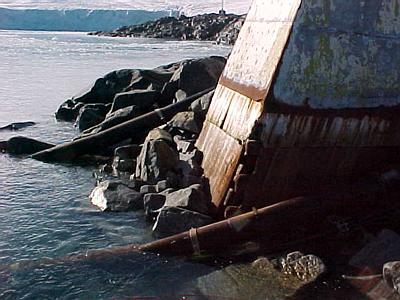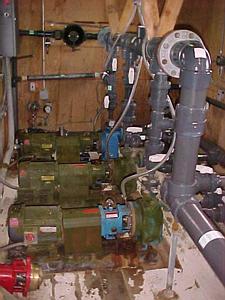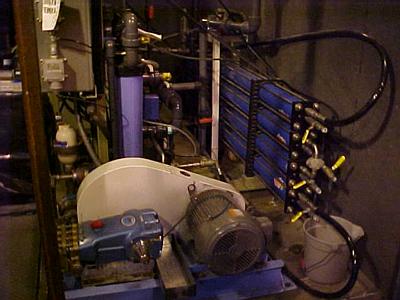2 April, 2000
Palmer Station's Water System
Question 43: Are there other temperature scales besides Celsius and
Fahrenheit?
Palmer Station, although surrounded by many forms of water, has to make its
own fresh water. It starts with the salty ocean water of Arthur Harbor. The
pump house and pier on the north side of Gamage Point pull in the water using
whichever of several intake pipes is not clogged with marine life. This past
September, the station crew replaced the mesh filters over the ends of the
4-inch pipes with long prefilters to solve the clogging problem. The intake
pipes have large-diameter steel armor around them to prevent them from being
crushed or ruptured by the grinding of icebergs and winter sea ice.
The pump house has three motors, two of which are used at a time to pull in
the sea water. Before the filtering process that turns salt water into fresh
water begins, a pipe carrying some seawater goes out to both main buildings.
Some of it goes directly to the aquarium. The rest is used for flushing
toilets.
The first coarse filtration occurs in the pump house with a group of three
round barrel-shaped filters that hold 500 lbs of sand and 250 lbs of gravel
that the water is forced through. After it reaches the bottom, the water is
drawn off through a rosette of filter tubes and travels up to the generator
room on the first level of GWR through insulated pipes.
The water then goes through a fine filtration system called an RO (Reverse
Osmosis) filter that removes virtually all of the minerals and salts in the
water. Larger parcticles have already been removed in the sand drums. After
coming up the hill, the water pressure is very low, so the RO has another
motor to drive water through the filter. It puts up to 800 psi (pounds per
square inch) through the pistons and filter cylinders of the RO, producing up
to 2.8 gallons of fresh water per minute. Our water here has 80 parts per
million salts; with distilling it can be made still cleaner, but it would then
have a chelating effect (drawing minerals such as calcium from our bones).
City water systems in parts of the US call water with 200 parts per million
clean.
Once the water has been filtered, it is piped down to the two fiberglass
storage tanks in BioLab. They each hold 1500 gallons. They are 7 feet tall
and have a diameter of more than 6 feet. 45 people on station use
approximately 2500 gallons of water per day. We are usually not in danger of
running out of water.
The rest of the plumbing system is pressurized by a pneumatic container
powered by its own pumps. The pressurized water then flows through the last
stage of cleaning, a UV filter where it is exposed to UV light which kills 99%
of bacteria. The water is now ready to come out of the faucet. For hot water
there are water heaters in both buildings. Running warm water through outside
pipes would cool it before it reached GWR.
Answer 42: Use the formula: DegreesFahrenheit = (9/5 DegreesCentigrade)+32.
So 20C = 68F and 5C = 41F etc.

Armored intake pipes coming from Arthur Harbor to pump house.

Conduit and water pipes carrying the station's water supply. The pump house and pier are at the right with the large sea water pipe going to the RO filter in GWR. Other pipes go between GWR and BioLab.

Sea water pumps in pump house.

Coarse filter drums in pump house. Each is approximately a meter high.

The reverse osmosis (RO) filter array. The long blue tubes are the filter chambers. The motor that pushes the water through is in the foreground.

The water storage tanks for the station.

Contact the TEA in the field at
.
If you cannot connect through your browser, copy the
TEA's e-mail address in the "To:" line of
your favorite e-mail package.
|
